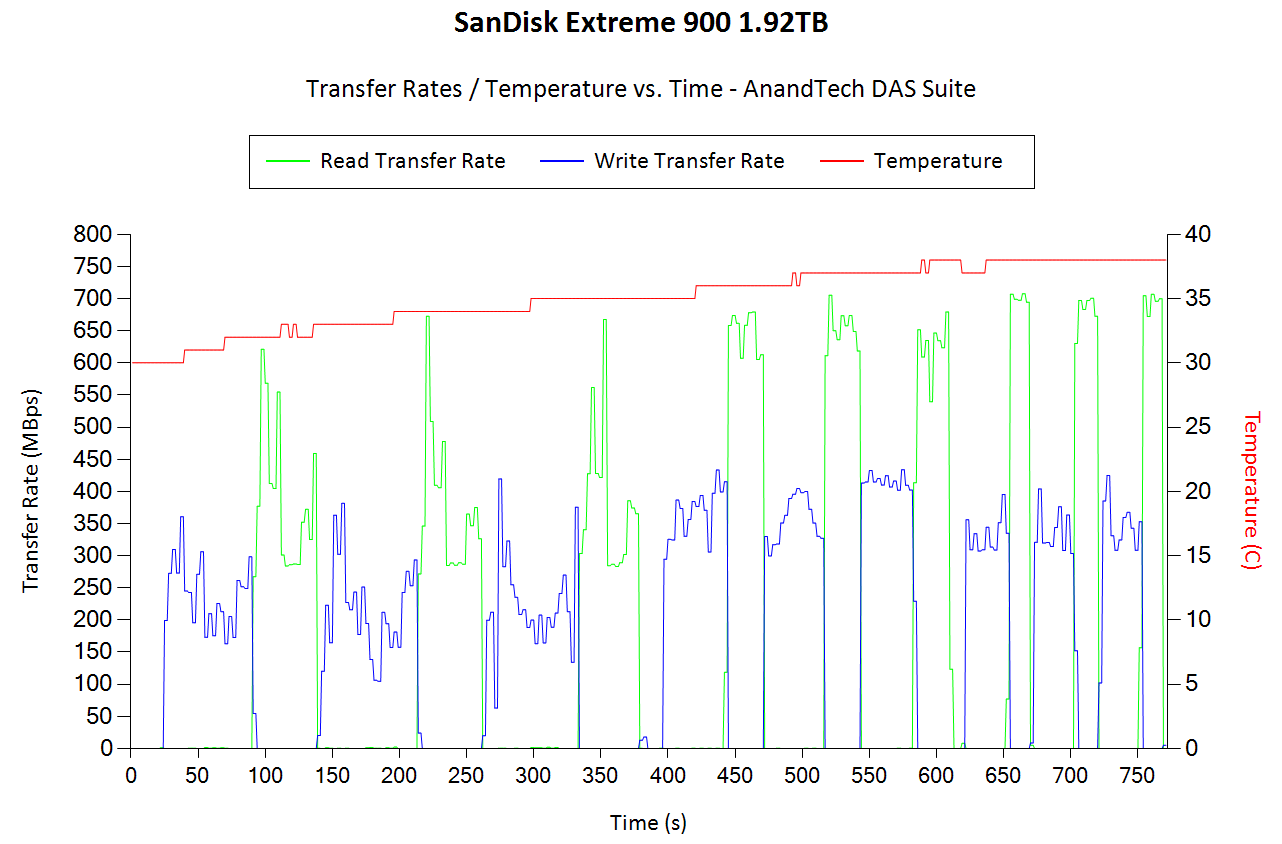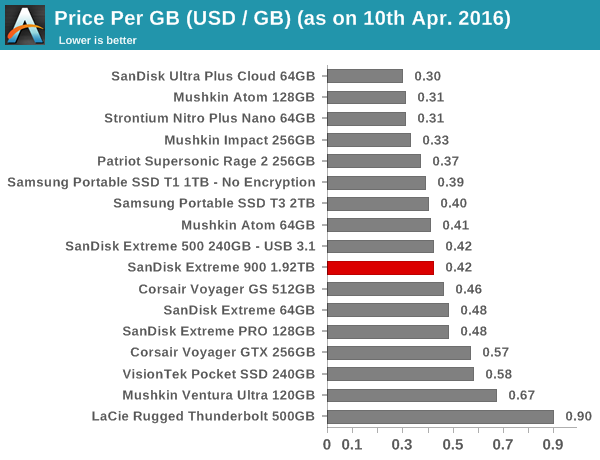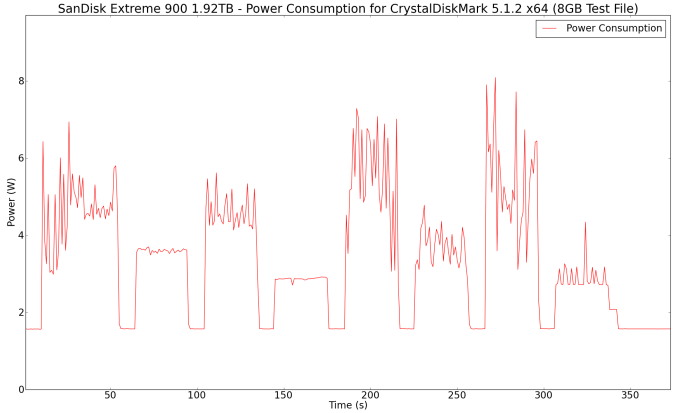SanDisk Extreme 900 USB 3.1 Gen 2 Portable SSD Review
by Ganesh T S on April 11, 2016 8:00 AM ESTPerformance Consistency
Performance consistency is an interesting aspect of flash-based storage devices. Aspects that may influence this include thermal throttling and firmware caps on access rates to avoid overheating or other similar scenarios. This aspect is an important one, as the last thing that users want to see when copying over, say, 100 GB of data to the flash drive, is the transfer rate going to USB 2.0 speeds. In order to identify whether the drive under test suffers from this problem, we instrumented our robocopy DAS benchmark suite to record the flash drive's read and write transfer rates while the robocopy process took place in the background. For supported drives, we also recorded the internal temperature of the drive during the process. The graphs below show the speeds observed during our real-world DAS suite processing. The first three sets of writes and reads correspond to the photos suite. A small gap (for the transfer of the videos suite from the primary drive to the RAM drive) is followed by three sets for the next data set. Another small RAM-drive transfer gap is followed by three sets for the Blu-ray folder.
An important point to note here is that each of the first three blue and green areas correspond to 15.6 GB of writes and reads respectively. Throttling, if any, is apparent within the processing of the photos suite itself.

Reads of large-sized files is not an issue at all, with transfer rates staying well above what is possible with a USB 3.0 interface. The main problem is the transfer of a large number of small-sized files (as in, photographs with sizes between 4 and 8MB). Depending on the state of the SLC / TLC cache, the completion of the writes (and, in turn, the write speeds) can vary quite a bit. As one can see from the second and third set of 'photo writes, the difference from run to run can be as much as 50 MBps. That said, the speeds are quite satisfactory overall.
Power Consumption
The power consumed by the SanDisk Extreme 900 1.92TB was measured under multiple scenarios. These scenarios were triggered using CrystalDiskMark 5.1.2 x64 with a 8GB test file and each test separated by a 10s interval. The initial part of the graphs below show the idle power consumption of the drive. This is followed by the power consumed when CrystalDiskMark prepares the 8GB test file on the drive. The eight distinct segments that follow show the power consumption profile for the workloads (single-threaded sequential and random accesses with a queue depth of 32, followed by sequential and random accesses with a queue depth of 1). The first four segments correspond to read accesses and the last four to write accesses.
The drive pulls around 1.57W from the host at idle. Write accesses are more power hungry, with a peak power consumption of around 8.1W. SanDisk suggests using USB ports capable of delivering up to 10W of power for optimal performance. It is obvious that using a port capable of delivering only the usual 5W will heavily hamper the performance of the unit.
Concluding Remarks
Coming to the business end of the review, the Extreme 900 shows that SanDisk is not unwilling to take a risk by developing products for a market still in its infancy. While USB 3.1 Gen 2 has been around for more than a year now, there have been no mass-market devices taking full advantage of the interface yet. The Extreme 900 is one of the first bus-powered USB 3.1 Gen 2 client devices available for general purchase.
The performance and capacity of the drive leaves us with no doubt that it would be great for quickly transferring large-sized multimedia files. The bus-powered nature ensures that it can be easily used in the field, away from AC power sources. Minor points of concern include the usage of TLC flash (leading to endurance concerns) and the inability to recognize and take actions on the drive based on S.M.A.R.T features such as TRIM.

Despite being one of the first USB 3.1 Gen 2 client devices in the market, the unit is quite reasonable priced in terms of price per GB. The SanDisk Extreme 900 1.92TB is currently available on Amazon for $800. The 2TB Samsung Portable SSD T3 is also currently priced at $800. It gives the user an extra 80GB, leading to a slight price per GB advantage for the Portable SSD T3.
Hardware encryption capabilities and the form factor aspect also favor the Portable SSD T3. However, the Extreme 900 performs better in most real-world benchmarks and also comes with the more recent USB 3.1 Gen 2 interface. SanDisk deserves praise for bringing a unique product to the market.












31 Comments
View All Comments
Holliday75 - Monday, April 11, 2016 - link
Do those $10 enclosures support RAID 0? I'm sure there are some on the market, but to support RAID 0, USB 3.1 gen2? Doubt there are many if any on the market.littlebitstrouds - Monday, April 11, 2016 - link
I've got this 2 bay 3.1 gen2 from Startech. Have two 480gb Sandisk Ultra II SSD's running RAID 0. I get 420 MB/s read and write with my Macbook Retina. I'm on the road, so I haven't tried them on my desktop, with true 3.1 gen2 support yet.http://www.amazon.com/StarTech-com-10Gbps-External...
ganeshts - Monday, April 11, 2016 - link
Nice one.. it is not $10, but $95, but a good solution for sure.Unfortunately, it is not bus-powered or as compact as the Extreme 900. That said, it is definitely more flexible with the configurable RAID levels.
jameskatt - Saturday, May 7, 2016 - link
I'd rather have a boring enclosure design that is as small and utilitarian as possible. No need for extra fins and doodads. Just do its job and stay out of the way.digiguy - Monday, April 11, 2016 - link
I wonder if we'll see at some point external enclosures capable of supporting PCIe SSDs that can saturate 10Gb/s and/or even use Thunderbolt 3 to transfer data up to 40Gb/sname99 - Monday, April 11, 2016 - link
"with a peak power consumption of around 8.1W. SanDisk suggests using USB ports capable of delivering up to 10W of power for optimal performance. It is obvious that using a port capable of delivering only the usual 5W will heavily hamper the performance of the unit."
I'm sorry but this is an unacceptable ending to a pretty good review.
There is no such thing as a "usual 5W USB port". A USB2 port will give you 2.5W, a USB3 port will give you 4.5W. Hoping that you'll be lucky and get more is a recipe for tears.
Next, since SANDisk provide an A-connector, what actually HAPPENS when you use a 2.5 or 4.5W port? I'm somewhat dubious of the claim that it will just "heavily hamper the performance". At the very least I'd like to see some testing of this, with verification that the device does not simply randomly disconnect when it wants to power-draw beyond the allowed limit. Even assuming it is well-enough engineered to run properly on these lower power-draws, how much of a performance hit are we talking?
This is part of a larger problem that, especially in the context of external drives (and, to some extent, WiFi equipment) AnandTech lives in blissful ignorance of the real world. Sure your labs don't contain a single devices manufactured before January 2016, but in the real world, a substantial use case for external USB drives involves their being swapped between different machines. THIS is why it REALLY matters to know how well they can handle being connected to older ports.
This is not just some weird corner case, like a person complaining "well you didn't test that new SATA SSD drive when you connect it to 2007 SATA-66 box, and I really care about that situation"; it gets to the actual fitness of purpose for I would guess many, if not a majority, of the use cases of this sort of external USB drive.
ganeshts - Monday, April 11, 2016 - link
No disconnects. Checked with a traditional USB 3.0 port. Some sort of throttling going on, which reduces the speed.DanNeely - Tuesday, April 12, 2016 - link
All hyperbole from name99 aside; some degree of benchmarking at lower power levels needs to be done for all high power usb flash devices for the next few years. Not necessarily the full suite; but one or two tests suitable to characterize what the fallback performance levels will be for people not having the latest and greatest hardware to plug them into.epobirs - Monday, April 11, 2016 - link
Which is why the SIIG USB 3.1 Gen 2 single bay enclosure comes with a dual host port cable, Type A on both ends.I have a 480 GB Patriot Blast SSD in it and it does a pretty nice job of saturating the SATA bus. Things should get more interesting if and when somebody produces an SSD controller that avoids the SATA bottleneck and taps into USB 3.1 fully.
TheUsual - Monday, April 11, 2016 - link
No 'The'? I don't think every device deserves a 'The' at the beginning of the review, just the very important, well known devices.